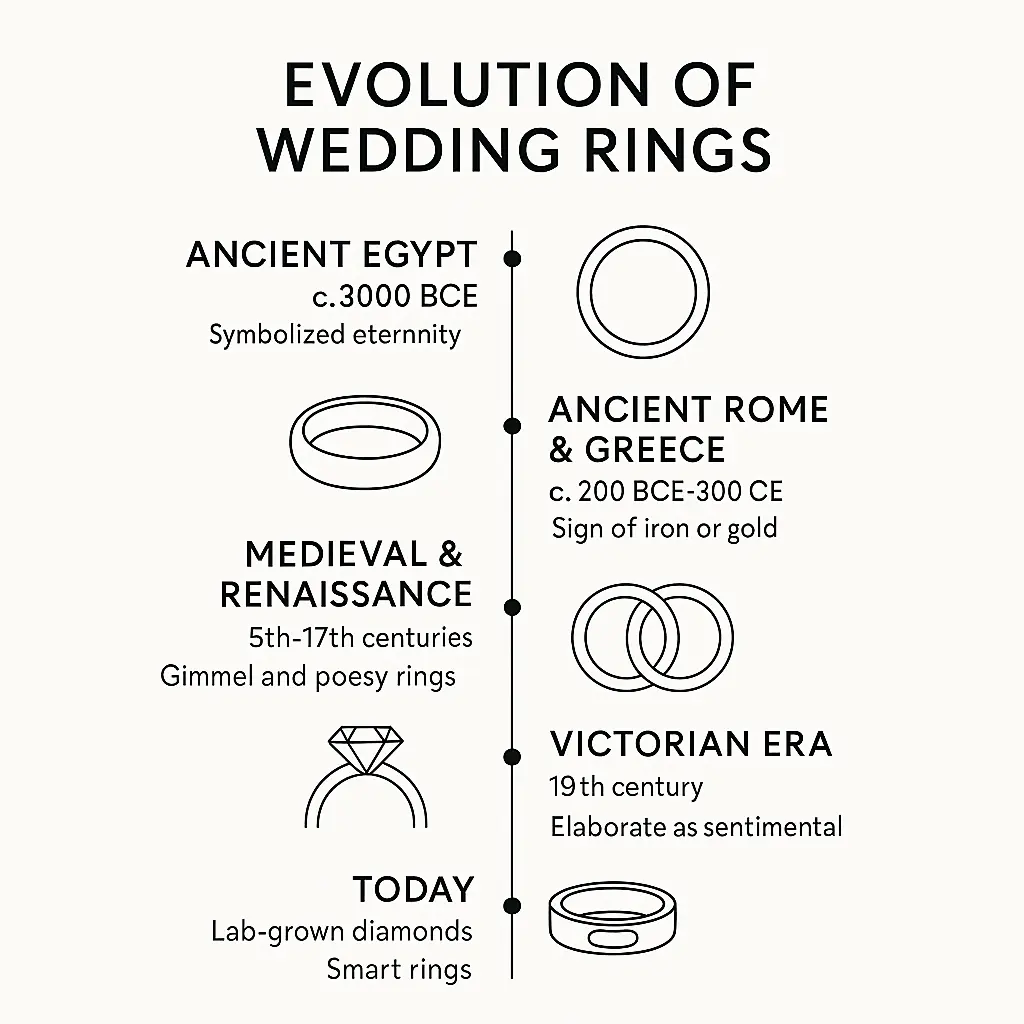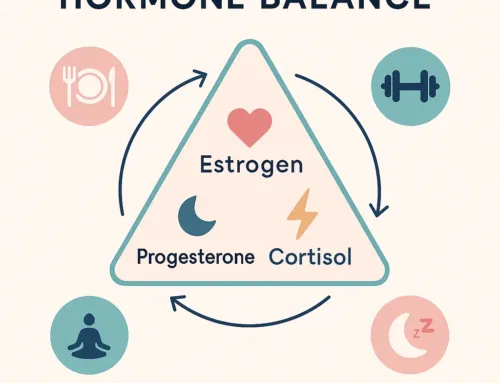
Approx. read time: 9 min.
Post: From Ancient Circles to Smart Bands: The Evolution of the Wedding Ring
Few symbols capture the promise of commitment quite like the wedding ring. Its familiar circle—endless, unbroken—stands for vows made in love, trust, and hope. Yet behind that simple shape lies a winding history, one that mirrors humanity’s shifting values, technologies, and tastes. From braided reeds along the Nile to lab-grown diamonds and NFC-enabled smart rings, the wedding ring has evolved in surprising ways. This article traces its journey through time, spotlighting key innovations and cultural shifts that shaped what millions wear on their left ring finger today.
The wedding ring symbolizes the eternal bond between partners and is often referred to simply as a ‘ring’ in many cultures.
Ancient Beginnings in Egypt (c. 3000 BCE)
The Evolution of Wedding Rings Through History: A Deep Dive into the Evolution of Wedding Rings
Our story starts in Ancient Egypt, where love and death intertwined in powerful symbolism. Egyptians wove simple bands from hemp, reeds, or leather, tying them into unbroken circles. The ring’s shape spoke of eternity—no beginning, no end—mirroring the cycle of life, death, and the afterlife that dominated Egyptian culture.
Understanding the Evolution of Wedding Rings not only highlights their aesthetic transformation but also reflects societal changes over the centuries.
They chose the fourth finger of the left hand because of a belief in the vena amoris, the “vein of love,” said to run directly to the heart. Exchanging rings wasn’t merely decorative; it marked a binding pact, a personal talisman against life’s uncertainties. Though these early rings bore no gemstones or metals, their meaning laid the foundation for millennia of wedding traditions to follow.
This tradition of exchanging a wedding ring has become a universal practice across cultures, where the ring serves as a physical embodiment of commitment.
Roman and Greek Contracts of Iron and Gold (c. 200 BCE–300 CE)
The ring tradition carried from Egypt into the Greco-Roman world, where its role shifted from sentimental to contractual. In ancient Rome, the bridegroom often gave an iron ring—called a ring of betrothal—to her father or guardian, sealing the marriage as a legal agreement. The iron’s durability symbolized strength and permanence in the marriage bond.
As trade routes expanded, wealthier Romans and Greeks began using gold instead of iron. A golden ring signaled higher status and economic stability. Public exchange of these rings turned weddings into communal social events rather than purely private affairs. By the end of the Empire, the wedding ring had become both a personal pledge of fidelity and a public declaration of social contract.
Medieval Rituals and Romantic Rings (5th–15th Centuries)
With the rise of Christianity, the Church formalized marriage as a sacrament, integrating ring-giving into its rituals. Clergy blessed the rings during the ceremony, invoking divine witness to human vows. This shift infused the ring with new layers of sacred meaning.
Two notable medieval styles emerged:
- Gimmel Rings: Crafted in two or three interlocking bands, each piece was worn separately by the betrothed until the wedding. At the altar, they snapped together into one solid ring, symbolizing two lives uniting as one.
- Poesy Rings: Slim bands etched with romantic inscriptions or mottos in Latin or early vernacular languages. These verses—often about devotion and fidelity—turned each ring into a miniature love poem.
Though gemstones remained rare, metalwork and engraving flourished. Rings became intricate tokens of both faith and courtship, setting the stage for the gem-studded designs of the Renaissance.
Renaissance Sparkle: The First Diamond Engagement (1477)
Diamonds entered the story in 1477, when Archduke Maximilian of Austria surprised Mary of Burgundy with a slim gold band featuring a row of pointed diamonds. This dazzling gift became the first recorded diamond engagement ring, intended to cement their political alliance with an unbreakable emblem of loyalty.
In the following century, diamond rings spread among European nobility. Their price and scarcity made them status symbols, rewards for royal favor and markers of dynastic power. Yet despite their elite origins, the custom of gem-set engagement rings gradually trickled down to the emerging merchant classes, planting seeds for the gemstone boom of later eras.
Victorian Sentiment and Symbolic Flourishes (1837–1901)
Queen Victoria’s long reign brought a surge of romance to jewelry design. Under her influence, wedding and engagement rings became canvases for personal storytelling. Lockets, woven hair, miniature paintings, and enamel work adorned bands with deeply intimate details, often linked to mourning customs as well as courtship.
Geometric motifs—hearts, bows, flowers—spoke a private language of love. This era’s rings were layered with symbolism: ivy for fidelity, daisies for innocence, forget-me-nots for lasting memory. Mass production toward the century’s end made these sentimental pieces accessible to a broader public, dissolving some class barriers in wedding customs.
The Diamond Reign: 20th-Century Commercialization
By the early 1900s, diamonds were still expensive, but new mining techniques and marketing transformed them into the quintessential engagement gem. De Beers’ landmark 1947 slogan, “A Diamond Is Forever,” equated the stone’s supposed timelessness with eternal love. That message ingrained itself in cultures worldwide, driving demand through the postwar boom.
World War II also shaped wedding traditions. Soldiers adopted simple gold bands—“widow’s rings”—to carry a piece of home into combat. Upon returning, they popularized wearing bands on both men and women. By the 1950s, double-ring ceremonies—with coordinated engagement and wedding sets—became the Western norm.
Shifting Values: Ethics, Sustainability, and Diversity
Entering the 21st century, couples began challenging the diamond-dominated mold. Ethical concerns around conflict stones and environmental damage spurred demand for responsibly sourced gems. Today, lab-grown diamonds fetch a fraction of the price of mined stones and boast zero mining footprint. Likewise, recycled metals and vintage heirlooms appeal to eco-conscious and budget-minded buyers alike.
Beyond diamonds, colored gemstones—sapphires, emeralds, morganite—offer vibrant alternatives. Mixed metals (rose gold with white gold, platinum with yellow gold) let couples design bespoke looks. Some choose minimalist bands etched with coordinates or secret messages, trading flash for personal significance.
Design Innovation: From Stackables to Statement Solitaires
Modern ring design embraces both subtlety and spectacle:
- Stackable Sets: Several slim bands—plain, textured, or gem-studded—stacked in various orders. This modular approach lets wearers refresh their look over time or layer rings representing different life milestones.
- Minimalist Bands: Sleek, unadorned circles in polished metal or matte finishes. Their simple elegance appeals to those who favor understatement.
- Bold Solitaires: Oversized center stones, sometimes set in unconventional shapes—hexagons, marquise cuts, or freeform slabs of quartz. These designs reflect individualism and a desire to stand out.
- Asymmetrical and Artisanal: Rings intentionally crafted with irregular lines, hammered finishes, or mixed textures. Often made by independent jewelers, they carry a handcrafted ethos.
Celebrities and influencers drive many of these trends, yet social media platforms also empower DIY designers and micro-brands to reach engaged shoppers worldwide.
The Age of Smart Rings
The latest evolution brings technology to this millennia-old tradition. Smart rings—sleek bands embedded with sensors—track health metrics like heart rate, sleep quality, and activity levels. Some integrate NFC chips for contactless payments or secure digital keys for homes and cars.
Modern innovations have even led to the creation of smart rings that combine technology with the traditional symbol of the wedding ring.
By merging practical functionality with symbolic meaning, smart rings blur lines between jewelry and wearable tech. They cater to partners who value both sentiment and innovation, offering a modern twist on an ancient promise: in sickness and in health, the ring watches over you.
Why the Ring Endures
Across four thousand years, the wedding ring’s core symbolism—an unbroken circle of devotion—has never wavered. Yet each era shaped the ring to reflect its priorities:
- Ancient Egypt: Spiritual beliefs in eternity and the afterlife.
- Rome and Greece: Legal pacts and social contracts.
- Middle Ages: Religious sacrament and medieval courtship poetry.
- Renaissance to Victorian: Royal politics, romantic sentiment, and the rise of personal expression.
- 20th Century: Luxury marketing, war-time pragmatism, and normative traditions.
- 21st Century: Ethics, customization, and the marriage of form with function.
The ring survives because it adapts. It absorbs new materials, technologies, and values while retaining its simplest power: a compact token that two people can share, wear, and revisit every day.
Choosing Your Ring Today
If you’re planning to propose or exchange vows, here are a few tips for navigating today’s diverse market:
- Define Your Values: Ethical sourcing? Vintage charm? Technological edge? Let your priorities guide choices.
- Consider Lifestyle: Active wearers may prefer durable metals and low-profile settings to avoid snagging. Smart rings add utility but require occasional charging or app integration.
- Set a Budget: Wider price ranges mean you can find meaningful options at many levels. Lab-grown gems and alternative stones expand possibilities beyond the traditional “three months’ salary” myth.
- Personalize: Engraved dates, hidden symbols, or unconventional stones make your ring uniquely yours. Collaborate with an artisan jeweler or explore online custom platforms.
- Try Before You Buy: Ring styling can vary dramatically on different hands. Visit local jewelers or use virtual try-on tools to see how designs complement your look.
A Circle That Keeps on Growing
From braided reeds to diamond solitaires, gimmel bands to health-monitoring smart rings, the wedding ring’s evolution is a testament to human creativity. It shows how a simple circle can carry centuries of meaning, adapting to new materials, technologies, and ideals while still symbolizing the unbroken bond between partners.
In choosing a ring today, you join a lineage of couples who—across cultures and eras—have embraced this enduring emblem of unity. Your ring will reflect your story: who you are, what you value, and how you envision your shared future. Yet however it looks—be it a polished gold band, a recycled sapphire halo, or an NFC-enabled smart circle—its core purpose remains the same: to seal a promise, visible for all to see, around that fourth finger of the left hand.
In the end, the wedding ring is more than metal and stone. It’s a living tradition, shaped by thousands of years yet ever refreshed by each new generation’s ideas of love, commitment, and identity. As long as hearts seek to bind themselves together, the wedding ring will endure—circle after circle, forever renewed.
Related Videos:
Related Posts:
4 Powerful Morning Affirmations
Skin 5 Ways to Build Healthy Glowing Skin Naturally
Hippocampus Health and Aging 7 Powerful Strategies
In and out of Love: The 7 Truths Behind it All
Pride in Religion: Healthy vs Unhealthy
Amazon’s Ring Ends Police Access to User Doorbell Footage Amid Privacy Concerns
OOF Hunter Jumper Schooling Show Series
Destination I Do: A Wedding and Travel Affair
The Writer’s Circle @ Sherwood









